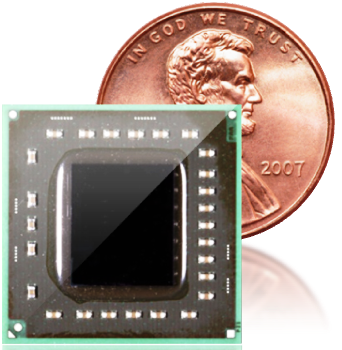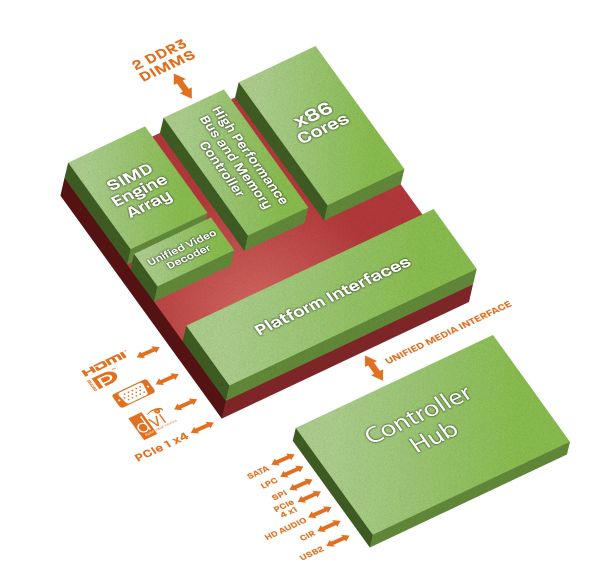AMD G-Series Brings APUs to the x86 Embedded Market
by Ganesh T S on January 19, 2011 12:29 AM ESTThe embedded market is huge and growing, and needs innovative, complete system platforms. These systems are compute intensive and have high performance graphics requirements, which make the embedded market a key part of AMD's strategy to drive revenue growth. There is an ongoing push for decreased power, smaller size and higher capability systems at lower price points. The strong visual element and growing need for quality graphics in many embedded markets such as set top boxes make it the ideal time for the AMD APU to get introduced into this space.

AMD's solutions (integrated CPU + GPU) are ideal for thin clients, medical imaging, point of sale and kiosk systems, gaming machines, digital signage and single board computing systems. These APUs integrate a multi-core CPU and a GPU sub-system on the same die to give a general-purpose, programmable scalar and vector processor core with heterogeneous capabilities.
The AMD Embedded G-Series Platform consists of an APU and a Fusion Controller Hub. The features are as below:
APU
- 2 x86 CPU Cores (40nm “Bobcat” core – 1 MB L2, 64-bit FPU)
- C6 and power gating
- Array of SIMD Engines [ DX11 graphics performance, Industry leading 3D and graphics processing ]
- 3rd Generation Unified Video Decoder [ H.264, VC1, DivX/Xvid ]
- DDR3 800-1066, 2 DIMMs, 64 bit channel
- BGA package
AMD Fusion Controller Hub for display and I/O
- Two dedicated digital display interfaces [ Configurable externally as HDMI, DVI, and/or Display Port, and as single link LVDS for internal panels ]
- Integrated VGA
- 5x8 PCIe®
- “Hudson” Fusion Controller Hub
With the introduction of the G-Series, AMD is showing a strong commitment to the x86 embedded market. AMD claims that it is the world's first and only APU for embedded systems. AMD Fusion can bring a new generation of differentiated, small form factor embedded systems that consume less power, yet deliver improved performance and features. The GPU component can deliver an outstanding visual experience compared to other x86 based embedded systems.
We are reproducing the different SKUs available for the APU as well as the platform controller hub (PCH) from AMD's official site below (click to enlarge):
Given ATI's strong GPU background, there is no doubt that the graphics in the G-Series will turn out to be much better than the embedded solution from Intel and VIA. However, we do have some concerns about the capability of the UVD engine in the platform. While the marketing slides indicated that Blu-Ray titles can be smoothly played back, it also had another entry indicating that 1080p video playback support availability was only in the 18W processors and higher. We were also not provided with the difference between the embedded G-Series and the desktop Brazos platform that Anand had covered earlier. It looks likely that the GPU capabilities (SIMD engine) are not the same, with the embedded solution having half the number of stream processors. However, we are awaiting confirmation on this. Expect an update in this section as soon as we hear back from AMD.













76 Comments
View All Comments
iamezza - Friday, January 21, 2011 - link
+1knedle - Wednesday, January 19, 2011 - link
I think this article should be read not as commercial, but more like "OMG, finally AMD is making a comeback!"Hrel - Wednesday, January 19, 2011 - link
I agree with you, I only scimmed cause it read so much like a commercial. Commercials aren't necessarily ALL positive. Mention pseudo negatives in an optimistic fashion to emphasize the positives; which is what this article is.Samus - Thursday, January 20, 2011 - link
What a crock, this is complete BS. How are they going to call this a single chip integrated SoC when its clearly two chips, with Hudson using as much power as Brazos?Embedded G-series my ass, integrate the damn controller hub already and stop calling the kit something its not.
Tractor - Friday, January 21, 2011 - link
yes, i fully agree with this comment; i'm very surprised to see so many superlative positives in an anandtech article, and approximately no fact to support them.It's not only that expectations are very high, with no benchmark / measurement to back them; it's also about the tone, a few sentences here look like a dictated press release.
And maybe that's what it is.
kfiske - Wednesday, January 19, 2011 - link
This has to be a joke. It has no information and reads like an AMD pr release.pk05 - Wednesday, January 19, 2011 - link
No it doesn't...press releases are shorter and less hyperbolic.ganeshts - Wednesday, January 19, 2011 - link
Please look at my response to brunnis's post above.I still believe that AMD may probably have a better case than the embedded Atom chipsets, but that is a joke because the embedded Atom itself is not a efficient product.
But, this product has quite a number of customers releasing production systems soon.. So, we will have to wait a bit to determine the market reaction to it.
AMD could have made more of a splash by releasing a proper SoC. Not sure whether that is slated for the future.
pk05 - Wednesday, January 19, 2011 - link
Fair enough, thanks for the response Ganesh. I would recommend a different lead sentence, as that really does sound like a press release and sets expectations for the whole article.silverblue - Wednesday, January 19, 2011 - link
They have a revised architecture at 28nm in about a year's time. If they keep clock speeds as they are, that in itself should result in a good drop in power usage, not to mention the performance boosts usually associated with a revised architecture. I'm not sure they'll create a true SoC though, at least, not yet.I'm very happy to see AMD's first Fusion product line being so widely touted for adoption. I can't wait to see how the C series compares to the E series in a full suite of benchmarks, especially considering the E series should hit a bandwidth wall at some point much sooner than the C series due to lower CPU and GPU clocks.